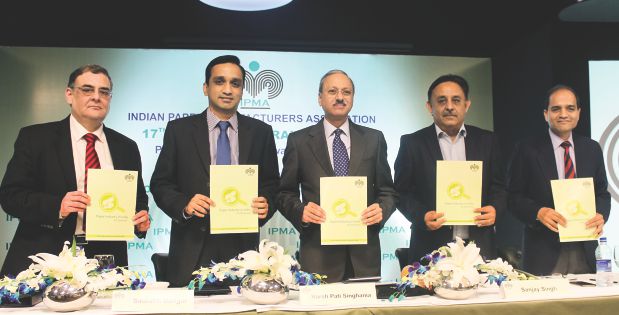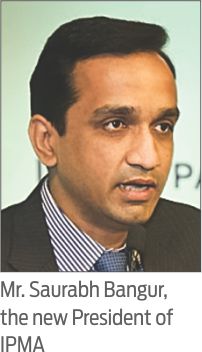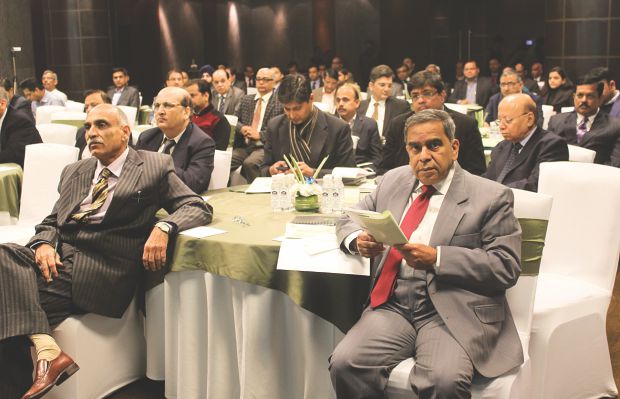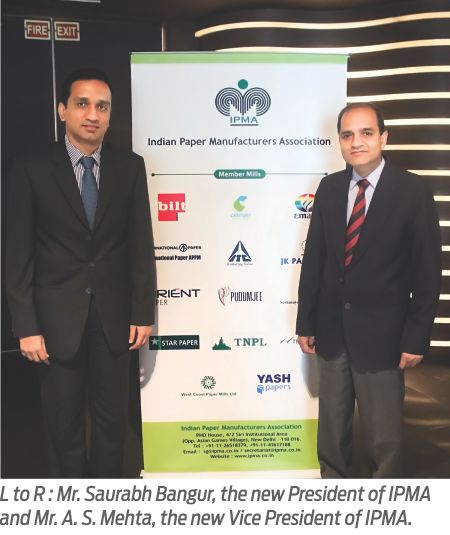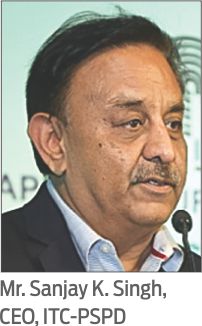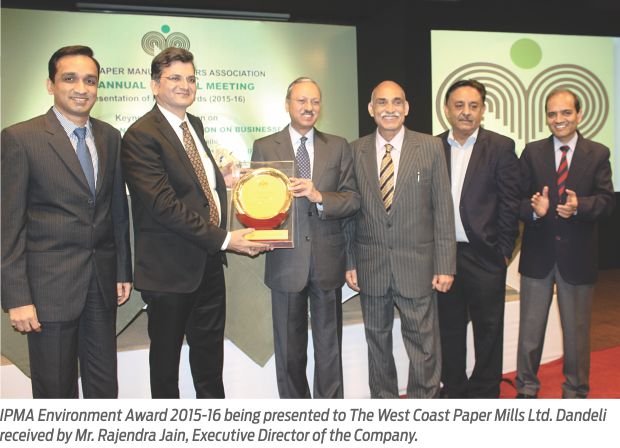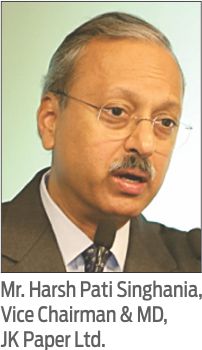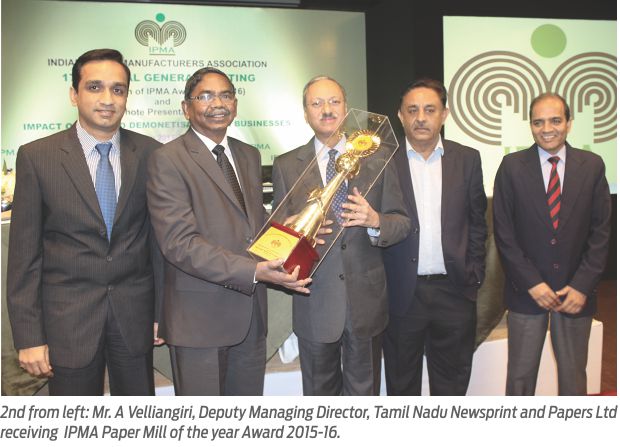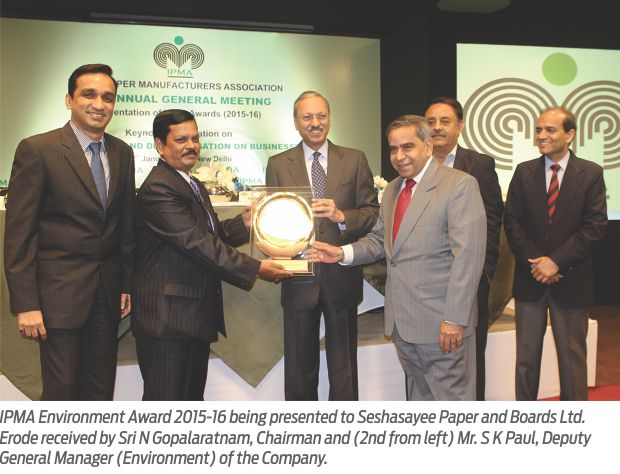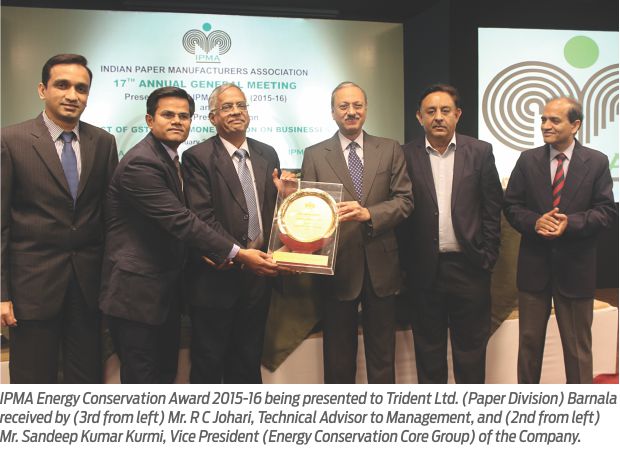The Indian paper market is undisputedly among the fastest growing. However, is the domestic paper industry ready to cater to this increasing demand amid some serious issues, viz. high raw material cost, rising imports of good quality paper, stringent environmental norms, etc.?
IPMA’s 17th AGM, held recently on January 12, 2017 at New Delhi, witnessed some key concerns of the Indian paper industry raised before a humungous gathering. Even after conceding that India is the fastest growing paper market in the world at 7 percent, all the speakers raised the viability and sustainability of this growth in the long-term, especially in a scenario where threats from rising cheaper imports, sustained fiber security, lessening industry’s environmental footprints, etc. are some questions warranting immediate attention.
Speakers unanimously highlighted the impasse created by these challenges in the way of extra capacity creation in sync with the rising consumption in times to come. For the industry to grow, the capacity has to go up, contented the speakers. Currently, the paper consumption in India is approx 15 million tonnes per annum (TPA). By 2024-25, under the baseline scenario, domestic consumption is projected to rise to 23.5 million TPA and production to 22.0 million TPA. About 1 million TPA of integrated pulp, paper and paperboard capacity is required to get created in India on an annual basis over the current capacity to meet the growing demand. However, is the industry willing to put the best foot forward in amid existing concerns and worries?
At the AGM, Mr. Saurabh Bangur, Vice Chairman, The West Coast Paper Mills took over as new President of IPMA. Mr. A. S. Mehta, President, JK Paper became the new Vice President of the association. Also, at the occasion, IPMA Awards were presented. IPMA Paper Mill of the year Award 2015-16 was presented to Tamil Nadu Newsprint and Papers Ltd. Trident Ltd. (Paper Division) was the recipient of IPMA Energy Conservation Award 2015-16. IPMA Environment Award 2015-16 was conferred upon Seshasayee Paper and Boards Ltd. as well as The West Coast Paper Mills Ltd.
The Paper Industry: Most Potential Driver to Saksharta Mission, Make in India and Green India
Mr. Sanjay K. Singh, CEO, ITC-PSPD and outgoing President of IPMA eloquently highlighted the healthy performance of macroeconomic indicators in the country in the last few years and intertwined India’s GDP growth with the consumption growth in the paper industry at 7 percent rate, which makes the Indian paper market the fastest growing. “In the last two years, India’s economy has been celebrated as the fastest growing large economy in the world. At seven plus rate of GDP growth, India has overtaken China which has held the numero uno status for several years,” he said.
Mr. Singh raising the ‘negative’ perception issue said, “Paper industry continues to be afflicted with the misinformed notion that the industry is destroying natural resources. As opposed to the common perception, the paper industry in India is not cutting forests. Of the total demand for wood by paper industry, around 90 percent is sourced from this industry driven agro-forestry. In fact, the paper industry is growing more trees than what it is consuming, and is therefore wood-positive. Millions of people are gainfully employed in the growing and harvesting of trees in what is called Trees Outside Forests (TOF).”
Mr. Singh also lauded the sustainability drive of the industry and contended that few industries can match the sustainability that paper offers. His argument is true to large extent as paper is fully biodegradable and doesn’t cause any impact on the environment. Moreover, it is made from resources which are renewable and can be easily regenerated. The paper industry is not only conserving the environment but also regenerating natural resources. “Not only that, the paper industry recycles most of the waste paper that is generated. The industry recycles agricultural waste which otherwise would have been burnt in the fields. New breakthrough ideas are coming up to recycle the effluents. The paper industry has therefore struck a fine balance between growth and sustainability, unmatched by many other industries,” said Mr. Singh.
Mr. Singh also covered during his address the benefits of agro forestry, the paper industry’s environmental performance, and a reverse global trend rediscovering the joy of paper usage. He said, “In India an estimated 0.5 million farmers are engaged significant employment opportunities for the local community and contribution to rural economy. Through agro-forestry, over 1.25 lakh hectare of land has turned green.
“The industry has managed to bring down its energy consumption by about 20 percent in the last five years. Integrated paper mills in India generate 60 percent of the power they use by utilizing the black liquor from the pulping process. In the first cycle of PAT (Perform Achieve Trade) scheme of the Government (2012-2015), under the Nation Mission for Enhanced Energy Efficiency (NMEEE), the paper industry significantly over-achieved the mandated stiff targets for energy saving. On the water front, now, the integrated mills have reduced the usage to 50 cubic meters. Efforts are on to bring it further down to 40 cubic meters.
“World over there is a move to rediscover the benefits of using paper. Not only that, the world at large has also come to appreciate the environment friendly stance of the paper industry. According to a recent report, a large number of big corporate including Fortune 100 companies have let go of the message – reduce paper and save the environment – in their communication.”
Giving paper consumption growth projections, Mr. Singh hailed the Govt.’s economy initiatives as catalyst to paper consumption growth. Make in India will lead to a resurgence of entire manufacturing sector and paper and paperboard requirements are bound to rise, he said. Paper is still basic to education and projects such as Sarva Shiksha Abhiyan cannot be envisaged without paper, he added. “Given very low per capita paper consumption in India, its consumption is bound to go up in the coming years. By 2024-25, under the baseline scenario, domestic consumption is projected to rise to 23.5 million tonne per annum (TPA) and production to 22.0 million TPA. About 1 million TPA of integrated pulp, paper and paperboard capacity is required to get created in India on an annual basis over the current capacity to meet the growing demand,” he said.
Mr. Singh further said that such investments, would create a multiplier effect on the economy through gross capital formation of INR 8,500 Crore every year, direct employment to 15,000 people every year and further giving additional livelihoods of 72 million man days per year (for people involved in agro / farm forestry). He also warned that if the investments are not made, the growing demand will be met through imports, which will result in a substantial foreign exchange outflow. The compounding effects of this over a 10 years period are truly staggering. While the industry has already made significant capital investments to ramp-up capacities, the gestation period is long and the economic viability of the investments has been impacted significantly by raw material scarcity and rising imports.
Raising key industrial concerns raw material availability and threat from rising imports, Mr. Singh sought pro-active initiatives on part of the Govt. to help the paper industry surmount these persistent issues and grow unhindered. He said, “Availability of wood domestically at 9 million TPA is inadequate compared to demand, which is currently about 11 million TPA and is projected to rise to 15 million TPA by 2024-25.” He pointed out that rising cost of fiber has rendered the domestic paper production as costly and uncompetitive to overseas producers, especially when the Govt. is extending preferential tariff treatment to import of paper and paperboard under the free trade agreements (FTAs).
“Substantial quantities of paper and paperboard are imported into the country at significantly lower costs under the aegis of the FTAs. In the last five years, imports have risen at a CAGR of 15.5 percent in value terms and 15.8 percent in volume terms. What is alarming is that imports are growing at a very high rate as compared to the increase in domestic production rate,” he added. “Imports of paper and paperboard, excluding newsprint, into India from ASEAN in the last five years have grown at a staggering CAGR of 37.5 percent in value terms and 38.5 percent in volume terms.”
Mr. Singh talked of some safeguard mechanisms on the lines of the USA and EU, both of which form the conventional market for China and Indonesia. In both these markets, anti-dumping/anti-subsidy tariffs have been imposed on import of paper/paperboard to protect their domestic industries. “Moreover, increased import of paper and paperboard is severely impacting the economic viability of many paper mills in India apart from revenue loss to the Government. As things stand today, there is a very serious threat of existing investments in capacities turning economically unviable,” said Mr. Singh. “It is hoped that the Government will earnestly look at the concerns being faced by this vital manufacturing sector. The paper industry is much better placed to drive Government’s initiatives of Saksharta Mission, Make in India and Green India.”
Is the Paper Industry Prepared to Tap the Consumption Growth?
“It may be a matter of debate whether we grow 7.5 percent or 7.7 percent or 7 percent, but we are clearly amongst or perhaps the fastest growing large economy in the world,” said Mr. Harsh Pati Singhania, Vice Chairman & MD, JK Paper Ltd. opening his address at the 17th AGM of IPMA. “We are a two trillion dollar economy and go well beyond three trillion dollars in terms of PPP.”
Mr. Singhania though agreed that the Indian paper industry has got tremendous potential, he contended that the paper industry is not so large anymore in terms of size if compared to several other industries. “We are all associated with paper industry and see this as our pride and passion. We are the core industry; we are very basic industry, fundamental to the growth of any economy. Going beyond statistics, numbers and size, we must really look at the impact that this industry has,” he said.
Talking specifically about the Indian paper industry, Mr. Singhania pointed out that the growth is possible in every paper segment even when these segments may have stagnated in other parts of the world. W&P and newsprint is on decline globally along with printed magazines dwindling and on the brink, he said. “The globally growing sectors include paperboard packaging and tissues. However, in emerging economies like ours, paper growth really happens because of very specific growth conditions and we have growth across all sectors of paper including globally flourishing packaging and tissue. So, uncoated wood-free white paper or maplitho is still going on. Even newspaper circulation has not declined in India as such. Other sectors like coated paper, packaging and tissues are growing at brisk pace,” he added.
“The kind of growth that paper consumption is witnessing in India is not visible in any other large country. At 7%, India will easily be the fastest growing paper market in the world. However, ‘Make in India’ in paper is seriously threatened in view of comparatively higher cost of raw material and surging cheaper imports which have been growing at a pace faster than growth in domestic production”, said Mr Harsh Pati Singhania,
Despite of steady consumption growth in India, Mr. Singhania also pointed to low per capita consumption in India as compared to global average and excess capacities elsewhere. “In Asia, thanks to China and Indonesia, we have huge excess capacities in W&P paper, in board and in pulping; there are pulp mills that are still being built on scales of millions of tonnes. China is not surplus on fiber rather it is deficit on fiber. But if you see China and Indonesia, China has a command because lots of Indonesian industries have invested in China that makes it one pool of low cost production,” he said.
“Brazil has emerged today as a huge global pulp supplier. Brazil is known for paper making on a large scale but then the cost of pulp is extremely low. Today, we are talking about wood cost in Brazil which is around USD 30-40 per tonne; in Indonesia it is probably USD 60-80 in some cases. But in India, we are in USD 140-150 per tonne! So, our inherent cost of manufacturing, because of a single element wood, is extremely high,” he added.
Mr. Singhania reiterating that India is one of the very few markets that are growing asked whether the Industry is prepared to take a plunge in this growth as the consumption is going to hit 26 million tonne mark by 2030 from the present 15 million tonne. “That is really the question that we need to ponder over and address the issues which really impair us or impede us from being a participant in this growth. I talked about one factor which is wood cost; it is very clear that we have cost disadvantage,” he said.
Mr. Singhania advocated convincing the Govt. to consider plantation on degraded forest land which will address fiber availability issue as well as other environmental issues. He also indicated that the present dispensation may allow the plantations on degraded forest land or other waste lands through a draft policy and that the national agro forestry policy has been approved and brought in this domain.
“This is a myth that paper industry is seen as a bad industry chopping trees and forests. If you see at the carbon footprint of making paper, yes, energy is consumed by chemicals and processes involved in paper making, but if you look at whole life-cycle and the footprint of other electronic medium like computers, smart phones, etc including the way of trying to dispose them off, this results in more energy footprint. There is a lot of education that needs to spread among policy makers and people to understand some of these realities,” said Mr. Singhania.
Paper, a Self-Sustainable Industry
While delivering his vote of thanks, Mr. Saurabh Bangur, the new President of IPMA, outlined briefly some of the major challenges faced by the Industry today. He said, “The after-effects of demonetization, GST and its implementation, adhering to some of the stringent air/water pollution norms set by CPCB, land availability for our raw material sustainability, etc. are some of the salient subjects which the industry needs to keep exploring and addressing.” Mr. Bangur also emphasized on the need to take seriously the issue of cheaper imports of good quality finished paper at NIL duty from nearby ASEAN countries.
“Today the industry is having a very different perception which needs to be changed by communicating the true picture. We at IPMA have always been strongly advocating the fact that the paper industry is not a green destroyer, but one of the few self-sustainable industries by virtue of farm forestry route undertaken by our member mills,” concluded Mr. Bangur.


